I drove it to school and I drove it to my first jobs and I drove it to the grocery store as I learned to shop and cook for myself. I drove it to the base of mountains and there it was three days later when I hiked down. I drove through lightening storms and downpours; I watched sunsets and deer and buildings in decay through its dusty windows. I slept in it in a Nebraska field and woke up covered in black crows. I parked it along a Tennessee river and emerged from swimming dripping in black leeches.
My first car was a silver Subaru Legacy I bought for less than $2,000 when I was a twenty-year-old college student. It had a sunroof, a five-disc CD player, power locks and windows, and 100,000 miles. As I sat in the Arizona DMV waiting to have it registered in my name, I felt I had arrived. The car had some idiosyncrasies: rain leaked from the overhead light soaking me as I drove, it didn’t start on cold mornings, and it guzzled an absurd amount of gas, but I loved it, and it gave me two things I prized above almost everything else: freedom and independence.
The car came with its original manual, thick and rectangular with an unbent spine, and I sat with it my first night of car ownership wanting to know how to fix simple problems, how to hold my own in a discussion of mechanics. I read it for about a half an hour until I decided my time was better spent on psychology homework. I never picked up the manual again. I drove into the desert and through forested mountains, down gnarly dirt roads and back and forth across the country five times without knowing how to change a flat, flush the transmission, or check the wiper fluid.
But I cared for my car the way I cared for my body—preventatively, meticulously. I asked the men who changed my oil: Had it been too long? Was it very brown? I paid mechanics to replace brake pads before they wore thin, 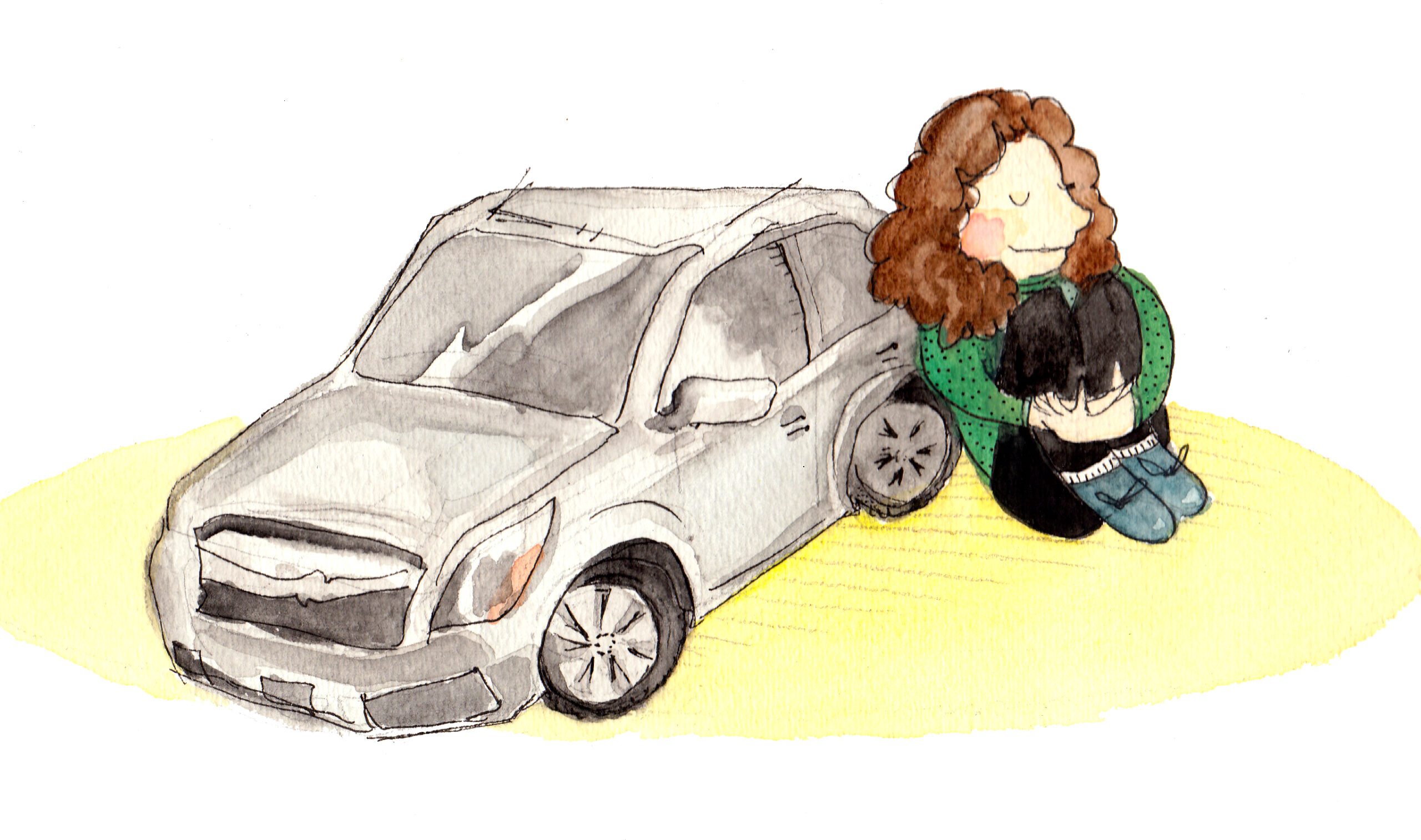 tighten belts when the seasons changed, replace bulbs and gaskets and hoses. I vacuumed the interior to save the air filters, dropping quarters into a machine for a long hose that would suck my floors clean of pine needles, crumbs, hair, and dried mud.
tighten belts when the seasons changed, replace bulbs and gaskets and hoses. I vacuumed the interior to save the air filters, dropping quarters into a machine for a long hose that would suck my floors clean of pine needles, crumbs, hair, and dried mud.
The scents of my first car were as familiar to me as the pheromones of a new love. The interior smelled sharp with grass and sage in the summer, sweet with the sugary decay of torn leaves in the fall, and dusty from hot radiator air in the winter. A polished tiger’s eye stone rolled around in the cup holder, and a feather hung from a red string around the rearview mirror.
When I graduated from college I was told by several mechanics that the car couldn’t make another trip from Arizona to Boston. The man I sold it to was a good man. He kept my address on a scrap of paper in the glove compartment and sent me updates on his drive from Arizona to Colorado as if the car were our shared child: The starter motor is a bit funny but it works when I put my hand on the belt and fiddle. A few days later: We made it safely via Monument Valley and Silverton. Spent most of the time using cruise control.
For months afterwards I dreamed of my silver Subaru in various states of danger. A few times it was in the middle of a dark ocean, and I paddled furiously but I knew I’d never reach it. Once I watched it careen, driverless, chaotic, along a busy highway, holding my breath and praying like a parent who could only stand by and watch her child make reckless choices. I felt it like a ghost limb.
A vehicle is a body—something you carry around.
*
Good girl! Did you do this by yourself? A mechanic asked me, a grown woman in business clothes, upon my lifting my own hood.
I’ve been an automobile owner for over twenty years and I’ve never had a woman change my oil, replace my windshield, or rotate my tires. There’s no other area in my life in which I so consistently and comfortably defer knowledge and power to men. I am a woman with plenty of skills, an iron will, and a sharp, analytical mind, but car maintenance is one area where I revert back to traditional notions of femininity—trusting, naïve, needing the rescue of burly masculinity in an oil-stained suit.
My mechanic’s office in Boston is plastered with calendar photos and magazine spreads of women draped over cars—women in bikinis, braless women wearing soaked-through tee shirts and cut-off jeans, naked women photographed from behind. I always thought it seemed out of keeping for the clientele in that suburban office—educated Boston professionals who stop by after work in their power suits and pumps to pick up their repaired cars. But no one seems to say anything. The mechanics have respectful interactions with their clients, patiently explaining what was done, what still needs to be done, as money changes hands and customers walk out with their single key flashing on a thin bit of twisted wire.
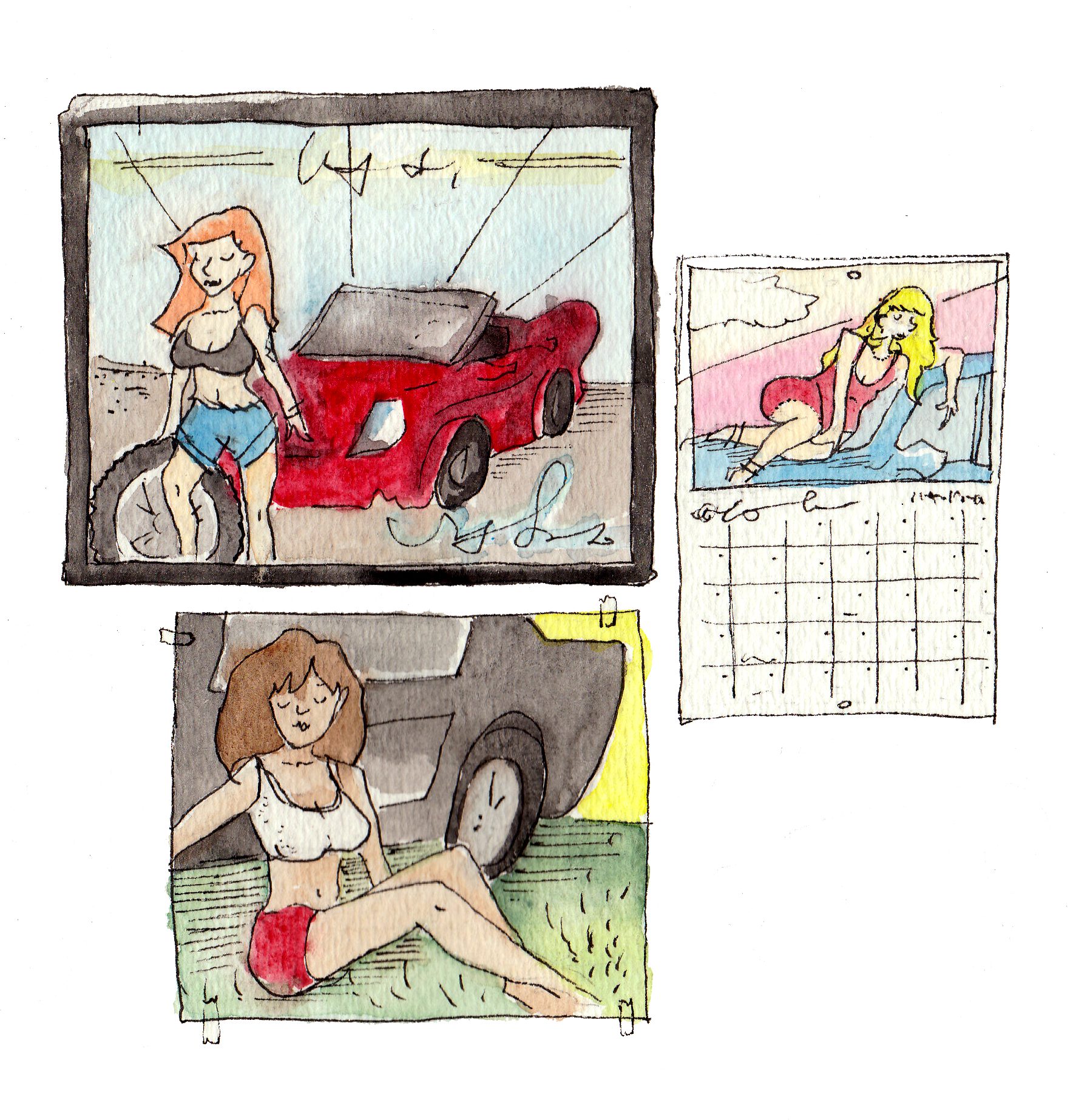 In what other place of business would such decor be acceptable or so routinely ignored? Imagine waiting in line at the bank, or sitting in a vinyl seat before a dental cleaning, or waiting to order a muffin at a bakery, with walls coated in glistening torsos and sultry stares. The mechanics are accommodating and respectful, they treat me with deference as they explain what they’ll need to do and why. Often when they’re talking I’ll glance up at a pin-up just over my shoulder, wondering if they can connect that we are both women, that the women on their walls get their cars fixed too, and could be sitting in my chair, mulling over the different prices of snow tires. If they treat me and their other female clients with such respect, how they can still keep those photos of women on their wall? Don’t they see we’re the same, save a layer of clothing, an attitude (likely feigned)? I always leave there with a working car, wondering when I’ll urge them to redecorate.
In what other place of business would such decor be acceptable or so routinely ignored? Imagine waiting in line at the bank, or sitting in a vinyl seat before a dental cleaning, or waiting to order a muffin at a bakery, with walls coated in glistening torsos and sultry stares. The mechanics are accommodating and respectful, they treat me with deference as they explain what they’ll need to do and why. Often when they’re talking I’ll glance up at a pin-up just over my shoulder, wondering if they can connect that we are both women, that the women on their walls get their cars fixed too, and could be sitting in my chair, mulling over the different prices of snow tires. If they treat me and their other female clients with such respect, how they can still keep those photos of women on their wall? Don’t they see we’re the same, save a layer of clothing, an attitude (likely feigned)? I always leave there with a working car, wondering when I’ll urge them to redecorate.
Why the link between sexy women and cars? Women drove automobiles as soon as they came on the market. They didn’t have to wait for the privilege as they did with voting or wearing pants. Is it because a man might view a car the way he might view a woman’s body—a thing of speed and sleekness, beauty, and power? Both are bodies to put in motion. Each can lend him a sense of power, virility; they are powerful machines to have responding to his touch. Curious about this history, I googled “female drivers.”
Here are the first five hits:
Women driving fails compilation – 2014 – YouTube
Woman fails theory test of driving 100 times
Top 10 reasons women can’t drive
These are the worst women drivers in the world
Why Saudi Arabia can’t ban women from driving forever
And results for “women and cars”:
Sexy women and fast cars
Photos of hot women and cars
Beautiful women and hot cars
Hot women and cars
Sexy women and cars
How does the old joke go? Why was Helen Keller a bad driver? Because she was a woman.
*
My mother drove a red Ford station wagon lined outside with fake wood paneling, and inside with tan pleather that got so hot in the summer it would burn the undersides of our legs to sit on it, the metal belt buckles reaching scalding temperatures. My mom would pick us up from day camp, windows rolled down, air hot and dry and smelling like melting plastic. We’d sit on damp towels to save our legs and suck on dripping popsicles mom had brought for us, paper towels wrapped around the bottom to catch the melt.
She was a quick and impulsive driver, accelerating fast and coming to short, jerky stops. She rolled through stop signs and inched forward of the white line at red lights, already halfway into the intersection when the light turned green. A policeman once pulled her over for this and she felt he was overly gruff and rude. I remember cringing in the backseat as she announced, Just because you have a gun on your hip doesn’t mean you’re a man. The police followed us home and spoke with my dad.
I learned to drive in Boston, where I grew up, and I’m an aggressive and confident driver. I’ve been pulled over dozens of times and issued a number of moving violations—speeding, running yellows, illegal turns. I’ve never paid one, and I, legally, still have a “perfect” driving record. I play a card I rarely pull. I make my eyes big and apologize profusely, all sweet and beseeching. Either I get off with a warning or when I go to the traffic office with ticket in hand I charm the man (it’s always a man) deciding. In most areas of my life I’m a bold and empowered woman, but this is empowered in a completely different way—a feminine way specific to vehicles. In response to such a male-dominated field of mechanics, highway patrollers, judges, I become the archetypal female—soft, smiling, needing the help and pardon of men. It’s at once completely fucked-up and not as problematic as it sounds. I drive off feeling like Thelma and Louise—gutsy, wild, free—my beauty working for me, not for them.
After a seven-day silent meditation retreat I was speeding down the Mass Pike from the Berkshires to Boston. Somehow deep feelings of oneness and expansiveness translated into blasting Krishna Das’ chants and doing 90 on a 75 mph highway. A cop pulled me over. I apologized sincerely, it is never ok with me to put my life or anyone else’s in danger. And then I asked a small question. Did he think the air in my tires was low? 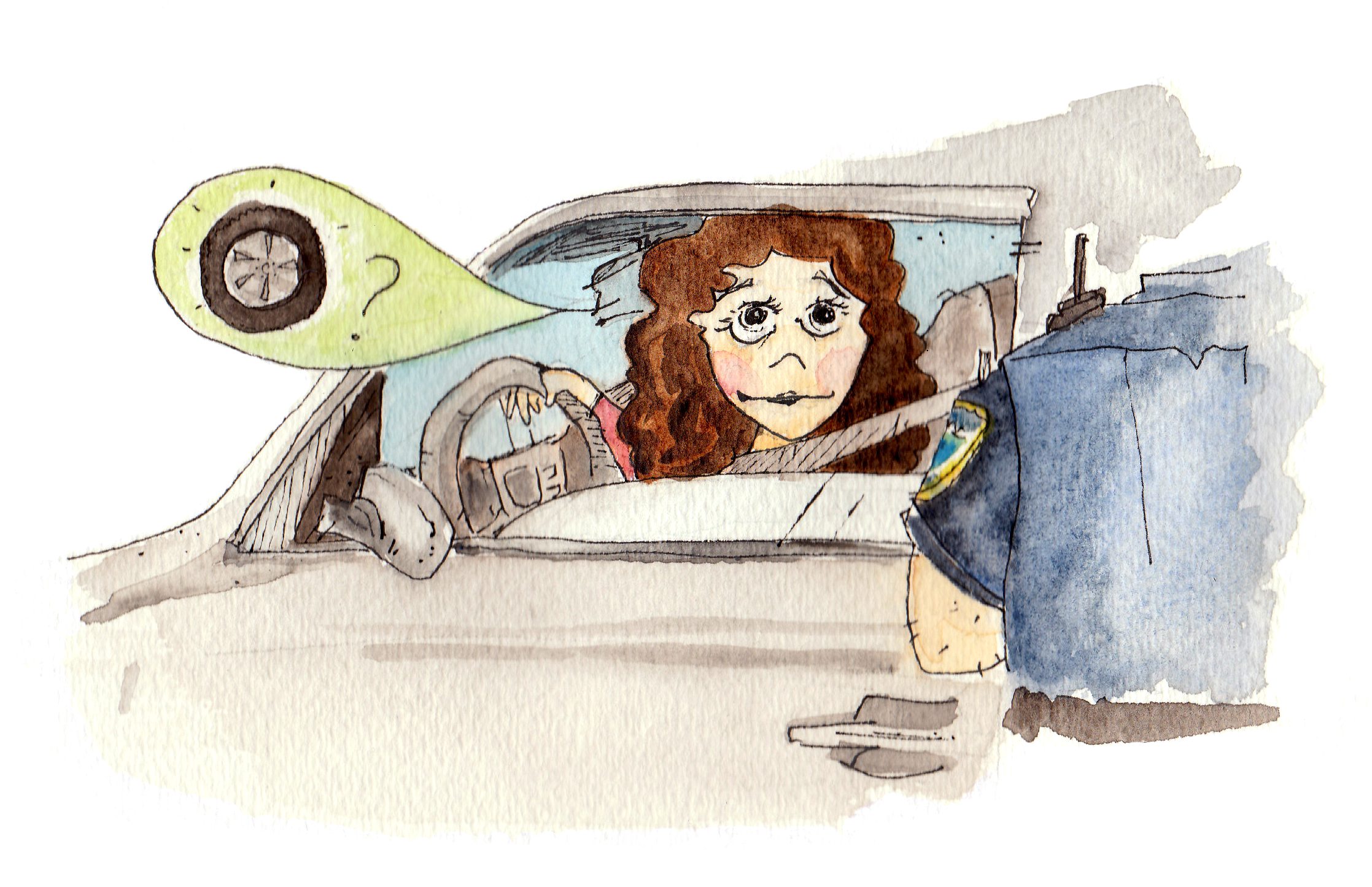 He leaned down and gave it a press. He said I could use some more air. Did he know of a gas station nearby? Just off the next exit, he informed me. I did legitimately want to know about my tires, and I also wanted him to see I was concerned with safety, but mostly, something in me knew to let him know something I didn’t, to let him help me, to be in control. I merged back onto the highway ticketless. And slow down, he called after me, as if remembering.
He leaned down and gave it a press. He said I could use some more air. Did he know of a gas station nearby? Just off the next exit, he informed me. I did legitimately want to know about my tires, and I also wanted him to see I was concerned with safety, but mostly, something in me knew to let him know something I didn’t, to let him help me, to be in control. I merged back onto the highway ticketless. And slow down, he called after me, as if remembering.
It feels powerful (even if it’s not) to be able to smile and get out of a ticket, to wear a low top and get a deal on a muffler. My car once broke down in New York City during a heat wave. I stood there, a lone white girl crying in a sticky summer dress deep in the Bronx, completely displaced. Countless men came to my aid—two ex-marines who pulled over and said, Sweetheart, you can’t be here, what do you need? A policeman asked, What are you doing in this neighborhood? How can I help you get out? Half a dozen mechanics sweated in their concrete garages to find the parts and fix my car so I could get home. Had I been a man, would any of these men have stopped their days to help me? If I hadn’t been white, would any of these black men in their black neighborhood have stopped their days to help me? Owning a car is a luxury, and I felt acutely aware of how many privileges I had at that time—I was young, white, attractive, alone. If one of those adjectives had been different I may have been left to fend for myself.
I once had a panic attack while driving alone on the highway from the Berkshires to Boston at night. My hands had gone numb and were like claws on the steering wheel. My head was full of images of me crashing, bloody, passing out, dying. At a tollbooth I told the operator, I can’t breathe. He let me pull off the highway and sit in his little lit cabin. He gave me paper cups of water from a gallon he kept under his desk and rubbed my back. Breathe, baby, breathe, he said, until I could get on the road again.
In these instances, I felt cared for and protected, and it felt lovely, familiar, and also unearned and inappropriate—daddy’s little girl. But I’m not. But I am.
*
Advertisements would have us believe that men want speed and flash from their cars, while women want reliability and protection. As a girl, I envied turtles and snails, who are at home wherever they go. I knew they could get crushed by a careless foot, by a bike tire or a car, but I was also jealous that in an instant they could withdraw from a dangerous or displeasing public to an immediate private, the most familiar place in the world, the inside of their own bodies. I was a nervous child, and I felt comforted at home. As I grew up, I learned a car can be a portable home, a way to carry privacy with me, a way for my soft flesh vulnerable to puncture, gash and bruise to experience an exoskeleton: steel, aluminum, glass.
A male friend who moved to America from a country where private ownership of cars is not the norm told me: it’s the first thing you learn here, you better get a decent car if you want to get laid. A woman, or the kind of woman I am, looks at a car like a small home, a place to relax into, lock the world out of, invite a select few into. I remember the safety and warmth I felt when my high school crush drove me home from school and let his car idle in the driveway. It was raining and our nervous conversation fogged the windows. He turned off the windshield wipers and I leaned back into the cushions, listening to drops ping on the roof. I remember nights my best friend would drop me off at home, and not ready to part we sat in the darkened car finishing old conversations, listening to the radio, or lying on the hood, our backs supported by the curved glass, moonlight entering through our eyelids.
I remember the blue Dodge minivan her mother drove. She would pick us up from school in between collecting day-old bread and pastries from local bakeries and delivering them to a food pantry. We’d slide open the van doors and wafts of warm yeast and sugar enveloped us with undertones of lemon curd or raspberry jelly, poppy seed or garlic. Our day was over as we chose a bag to open and pulled out a slightly stale croissant or a slice of thick rye as a snack for the way home, sinking back into the doughy folds of mothers.
My dad’s car was less familiar to than me than my mother’s; it was a blue boat of a Buick with soft blue interior like short carpeting. He took his car to work everyday, and rarely picked us up from school, camp, friends’ houses, ceramic lessons, and soccer. But we’d take it on long family trips, my brother and I lying in the backseat poking each other and watching for punch-buggies or playing word games, listening drowsily to my parents’ voices from the front seat, fading into dreams.
A car is a way of being in the same body—four heartbeats speeding towards a common destination.
*
Like our bodies, cars are fallible, and like life, driving is dangerous or fatal. A good friend died in a car accident in high school, and every year in my hometown there are several deaths of new teenage drivers. Adults can have accidents too. They fall asleep, they drink, they speed, they text and fiddle with the radio dial and are blinded by rain, they talk on their phones and their brain focuses on the conversation and away from the road. I know that to travel is not always to arrive.
A car is a capsule of faith and fate, the breath inside hoping.
I once brought my car in to be fixed for a blown tire and the mechanic told me there had been a bubble, that I was lucky it hadn’t burst on the highway.
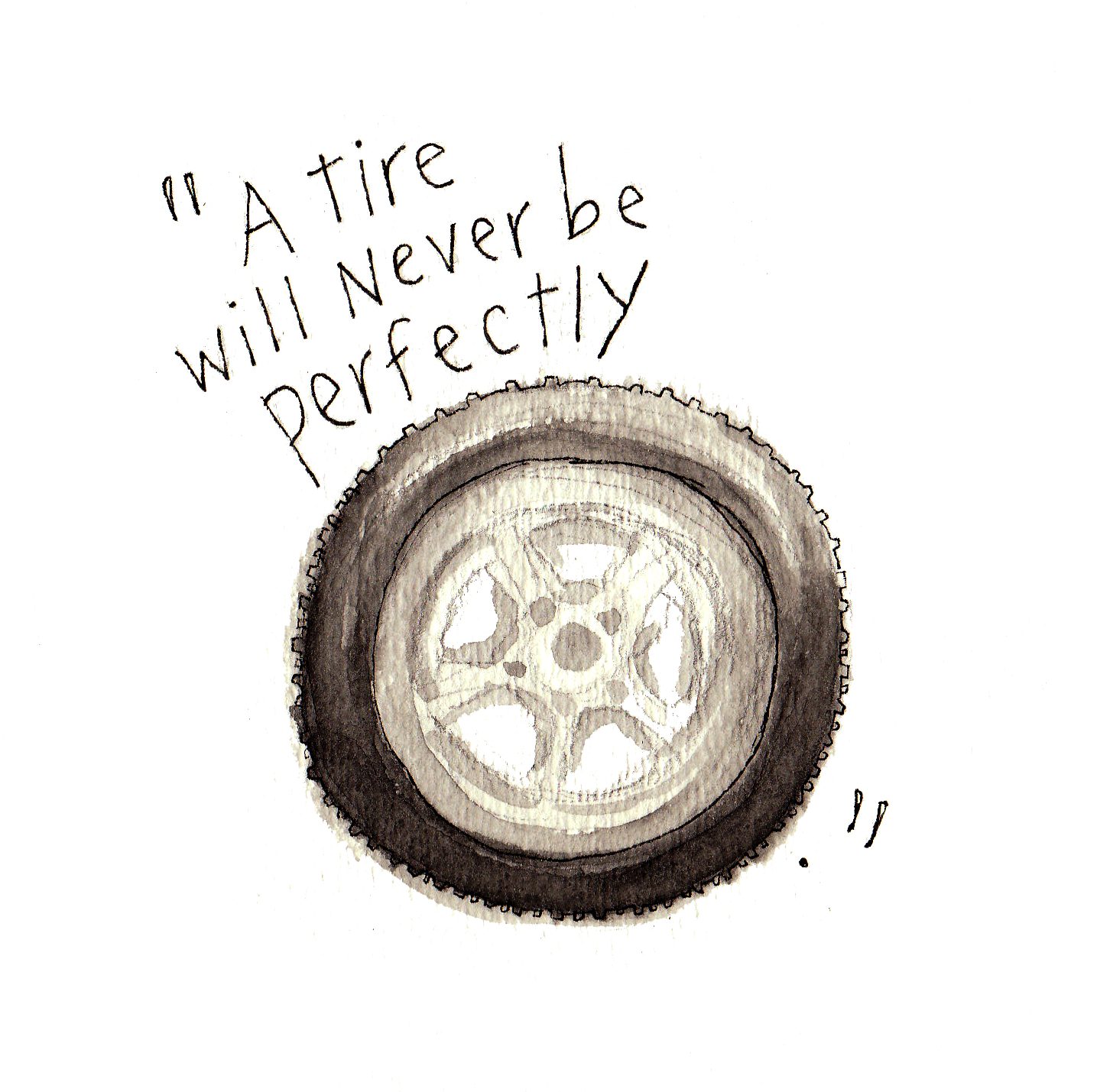 Why was there a bubble? I asked.
Why was there a bubble? I asked.
Because the tire wasn’t perfectly round, he said.
Why wasn’t it round?
Because humans make tires. And since humans aren’t perfect a tire will never be perfectly round.
We’re human, after all, men, women, and all outside of and in between those distinctions. We each want to experience power, safety, beauty, seduction, and freedom. I dreamed of the mechanic that night. As again and again he said, a tire will never be perfectly round, I could see his words blooming above his head, only in my dream the word round became a sphere itself, a slowly turning wheel, and we rested in the perfect curves of that word.
*
Car travel is the perfect combination of being where you are and arriving somewhere better. It’s acceptance with an escape plan, an intimacy with the self as the road passes smoothly under the tires and the mind alternates between euphoric perspective and dismal boredom. In a car alone one is free to sing as flamboyantly or shamelessly emotionally as one likes, belting out the vulgar along with the sentimental, and to cry as pitifully as one can while keeping just enough of one’s vision on the road. To witness others emoting in their cars is to see a pantomime. From the outside they are silently sobbing, soundlessly screaming into their phones, uninhibitedly belting a chorus, raw and honest. We, locked in our protected boxes, are all screaming, raging, singing, laughing, our breath fogging the windshield, while outside the lights go: green, yellow, red.
***
Rumpus original art by Kaili Doud.
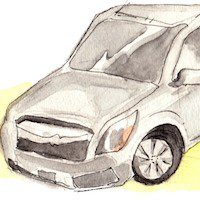




2 responses
I love this article, full of honesty and insight. The quote from your mother is laugh out-loud funny–I want to use it sometime, only I’d rather not get pulled over, again. I’m much older than you, but yes, guilty of playing the get-out-of-ticket-free card by smiling, apologizing, and (once upon a time) being young and attractive enough to fluster. The problem is when you hit middle age, the cops, hell everybody, seem to start enjoying telling you there’s no way out–end of the line lady.
The problems of car repair are so many, but like being caught speeding, they insert women into segments of society or industry that bar any impulse towards feminism at the crossroads. The only way to get out unscathed is to acknowledge it by acting like June Cleaver or Marilyn Monroe. Submit to the stereotype and they just might let you go, as long as you know your place. Those pictures in the background are there to remind you who they think you are, and if you don’t know it, they’ll charge you accordingly. Even if you do.
A couple of years ago, I was being charged, knowing full well what the problem was, (and arguing the issue), $1,600 to have my car repaired. I had my male partner call, and after five minutes, it was $700. I know I’m not alone in paying more for less because I’m a woman.
And, I’m also an aggressive Boston driver, but as I get older I realize that sometimes people aren’t always on the road to better places–they could be headed to chemo appointments, demeaning jobs, or funerals. So the next time you get to try around some old geezer, remember that might be you some day. In the meanwhile, treasure your means to freedom, but slow down and enjoy the ride.
I love both the article and the response as well as the mother’s line. As a now middle age woman, I am experiencing more of what the response article refers to but when I was in my thirties, I was self-employed working in that male dominated auto industry. This is exactly the reason I always thought someone should make a movie about car dealers from a real women’s perspective and not the Hollywood male version of a real women’s perspective. So I wrote the one I would like to watch. Maybe someday I can find the funds to get it made but in the meantime, so nice to read other women’s thoughts on this subject that are so similar to my own and that I seldom get to hear anyone discuss. Thanks to the writer of this article and to the writer of the response for making my day. And I know it’s such a cliche but ‘you go girls!’.
Click here to subscribe today and leave your comment.